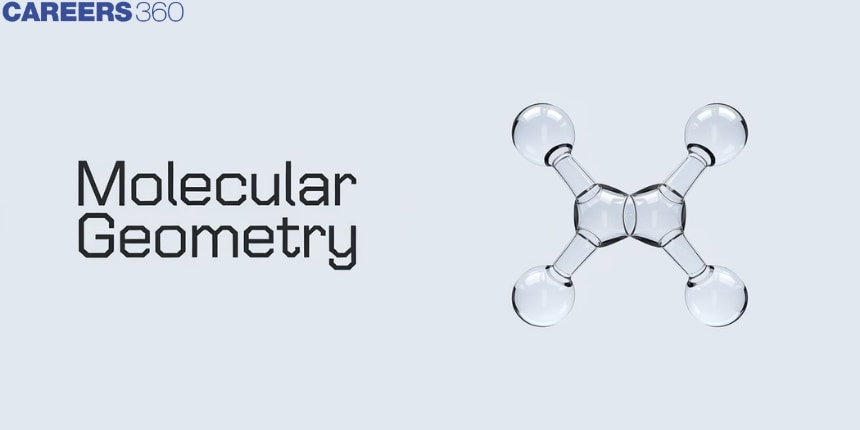Molecular geometry
Molecular geometry refers to the three-dimensional arrangement of atoms in space within a molecule. Based on the VSEPR theory, it would be learned that the form of the molecule will be determined based on the distribution of electron pairs around the central atom. Factors that affect molecular geometry are the number of bonding pairs, lone pairs, and the bond types—involving single, double, and triple bonds. Common molecular geometries include linear, bent, trigonal planar, tetrahedral, trigonal bipyramidal, and octahedral.
NEET 2025: Mock Test Series | Syllabus | High Scoring Topics | PYQs
JEE Main: Study Materials | High Scoring Topics | Preparation Guide
JEE Main: Syllabus | Sample Papers | Mock Tests | PYQs
- Predicting The Geometry Of Molecules
- Some Solved Examples
- Summary

The ideal shapes of molecules, which are predicted based on electron pairs and lone pairs of electrons are mentioned in the table below:

Predicting The Geometry Of Molecules
The following procedure uses VSEPR theory to determine the geometry of the molecules:
Write the Lewis structure of the molecule or polyatomic ion.
Count the number of regions of electron density (lone pairs and bonds) around the central atom. A single, double, or triple bond counts as one region of electron density.
Identify the electron-pair geometry based on the number of regions of electron density: linear, trigonal planar, tetrahedral, trigonal bipyramidal, or octahedral
Use the number of lone pairs to determine the molecular structure. If more than one arrangement of lone pairs and chemical bonds is possible, choose the one that will minimize repulsions, remembering that lone pairs occupy more space than multiple bonds, which occupy more space than single bonds. In trigonal bipyramidal arrangements, repulsion is minimized when every lone pair is in an equatorial position. In an octahedral arrangement with two lone pairs, repulsion is minimized when the lone pairs are on opposite sides of the central atom.
For example, BCl3 has three electron pairs and no lone pairs of electrons. Thus these three electron pairs will arrange themselves in a trigonal planar geometry as shown below. The bond angle between each B-Cl bond is 120oC.

Recommended topic video on (Molecular geometry)
Some Solved Examples
Example 1: In which of the following molecules/ions are all the bonds not equal?
1)SF4 SF4
2)SiF4 SiF4
3)XeF4 XeF4
4)BF4− BF4−
Solution
In SF4 Hybridisation is sp3 d and the shape is see-saw but all bonds are not equal. The length of the Axial bond is longer than the equatorial bond.
But, in SiF4, XeF4 and BF4− dBF4− all bonds are equal.

seesaw with the bond angles equal to 890 89∘ and 1770177∘ instead of the expected angles of 90∘900and 1800 180∘ respectively.
SiF4: sp3 hybridisation, and tetrahedral geometry.

XeF4 : Sp3d2 the shape is square planar instead of octahedral due to the presence of two lone pairs of electrons on the Xe atom.

BF4- : sp3 hybridization and tetrahedral geometry
Example 2: The maximum number of 900 angles between bond- pair, bond pair of electrons is observed in
1) dsp3dsp3 hybridisation
2) sp3 d sp3d hybridisation
3) dsp2 dsp2 hybridisation
4) sp3d2 sp3d2 hybridisation
Solution
Hybridization | Structure | Number of 900 Angle
dsp3 square Pyramidal 5
sp3d Trigonal Bipyramidal 6
dsp2 Square Planar 4
sp3d2 Octahedral 12

dsp2 dsp2hybridisation &sp3d sp3d or dsp3 dsp3 hybridisation
(four 90090∘ angles between & (six 90∘ angles between \
bond pair and bond pair) & bond pair and bond pair)
 sp3d2 sp3d2 hybridisation (twelve 900 90∘ angle between bond pair and bond pair)
sp3d2 sp3d2 hybridisation (twelve 900 90∘ angle between bond pair and bond pair)
Example 3: In which of the following pairs the two species are not isostructural?
1)CO32- and NO3-
2) PCl4+and SiCl4
3)PF5 and BrF5
4) AlF63-and SF6
Solution
PCl4+ and SiCl4 ⇒ both tetrahedral
PF5⇒ trigonal bipyramidal
BrF5⇒BrF5 square pyramidal
AIF63− AlF63−AlF63-and SF6 SF6 both are octahedral
CO32− CO32- and NO3- NO3−both are trigonal planar.
Hence, the answer is the option (3).
Example 4: The pair of species having identical shapes for molecules of both species is
1)CF4,SF4 CF4,SF4
2)XeF2,CO2 XeF2,CO2
3)BF3,PCl3 BF3,PCl3
4)PF5,IF5 PF5,IF5
Solution
Molecule Shape of the molecule
CF4 Tetrahedral
SF4 See saw-shaped
XeF2 Linear
CO2 Linear
BF3 Triangular planar
PCl3 Pyramidal
PF5 Triangular bipyramidal
IF5 Square pyramidal
Hence, the answer is the option (2).
Example 5: Which of the following statements is correct for ClF3 ?
1)All bond lengths Cl-F are identical.
2)All bonds are identical
3)Equatorial bonds are larger than axial bonds.
4) Equatorial bonds are smaller than axial bonds.
Solution
ClF3 has 5 electron groups/pairs around the central Cl atom ( Three bonds and two lone pairs). With 5 electron groups around the central atom, the molecule will adopt a trigonal bipyramidal shape.
F atoms occupy the axial positions and one F occupies the equatorial positions of trigonal bipyramidal arrangement. Usually, the bond length between the Cl - F axial is more than the Cl - F equatorial to reduce the repulsions between the lone pair - lone pair, bond pair - lone pair, and bond pair-bond pair repulsions, according to VSEPR theory.

Hence, the option number (4) is the correct option.
Summary
The common shapes are linear, bent, trigonal planar, tetrahedral, trigonal bipyramidal, and octahedral. For example, CO2 is linear, while NH3 has a trigonal pyramidal geometry due to a lone pair at nitrogen. Molecular geometry largely determines such things as polarity, reactivity, physical state, color, magnetism, and biological activity. .
Also Read
19 Feb'25 11:09 AM
07 Feb'25 10:38 AM
07 Feb'25 10:22 AM
07 Feb'25 10:18 AM
07 Feb'25 10:16 AM
07 Feb'25 10:11 AM
18 Oct'24 05:56 PM
18 Oct'24 10:52 AM
10 Oct'24 12:05 AM
09 Oct'24 11:41 PM